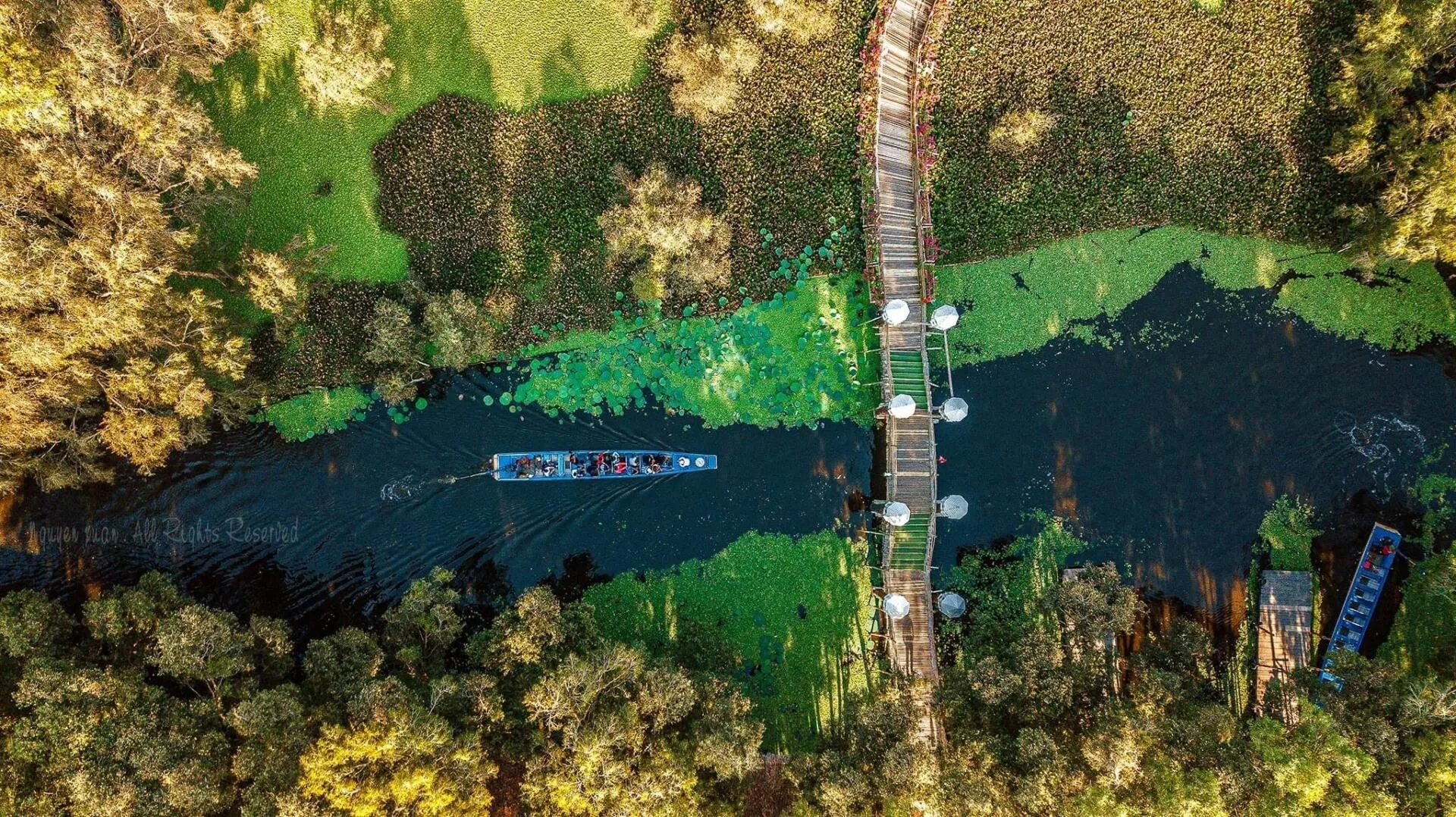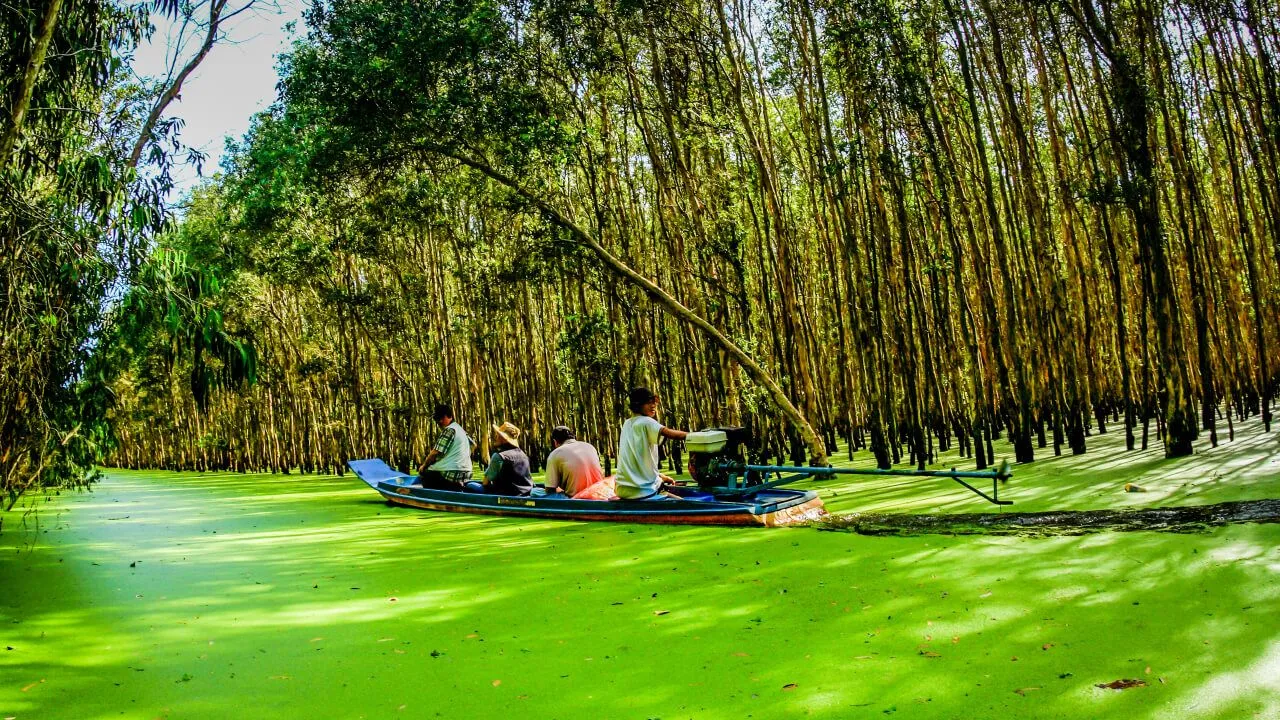The Mekong Delta’s floating water season has long been an indispensable part of Vietnam’s tourism picture, bringing unique beauty and vibrant life to this land. Among countless attractive destinations during this season, Tra Su cajuput forest stands out like a jade green gem, attracting visitors with its pristine, majestic beauty and unforgettable experiences. Coming to Tra Su during the flood season, you’ll feel like stepping into another world, where nature reigns supreme and the symphony of earth and sky echoes throughout the space.
Prime Location and the Story Behind the Name “Tra Su” Cajuput Forest
Hidden in Van Giao commune, Tinh Bien district, An Giang province, Tra Su cajuput forest is about 30km from Chau Doc city and about 65km from Long Xuyen city. This land was once a alum-contaminated, desolate area, and few would have imagined that it could transform into a top-rated ecotourism destination in the Mekong Delta. Thanks to a diligent land reclamation process and the construction of dyke systems to prevent flooding, Tra Su has been revived, donning the lush green coat of a cajuput forest, becoming an ideal destination for those seeking to reconnect with nature.

The name “Tra Su” itself carries an interesting story. Many believe that this name originates from Khmer, with “Ta” meaning “Grandfather” and “Su” in Sino-Vietnamese meaning “monk.” Thus, “Tra Su” can be roughly understood as “Grandfather Monk,” evoking a tranquil, sacred space, further enhancing the appeal and mystery of this cajuput forest. The harmonious combination of natural and cultural elements has created a unique Tra Su, unlike any other on the Mekong Delta tourism map.
Immerse Yourself in the Breathtaking Beauty of Tra Su Cajuput Forest During the Floating Water Season
The floating water season, usually lasting from September to November, is when Tra Su cajuput forest shows off its most brilliant beauty. The entire forest seems to put on a new coat, filled with a fresh green color stretching to the horizon. The vast water surface reflects the deep green cajuput trees, creating a vivid and enchanting watercolor painting. The space here becomes strangely peaceful, completely separated from the noise and bustle of the city, leaving only the chirping of birds, the rustling of wind through the leaves, and the gentle sound of oars stirring the water.
To fully appreciate the beauty of Tra Su during the flood season, you should come here in the early morning, from about 7 am to 9 am. As dawn breaks, gentle rays of morning sunlight creep through each leaf, shining down on the water surface, creating a shimmering, magical scene. The fresh, cool air and the cheerful birdsong will awaken all senses, bringing you a wonderful feeling of relaxation and refreshment. Or you can also come in the late afternoon, from 5 pm to 6 pm, to watch the sunset over the cajuput forest. The golden-orange afternoon sun dyes the entire space, the water surface sparkles with silver light, and flocks of birds gather to fly back to their nests, creating a romantic, memorable moment.

The flood season not only brings magnificent natural beauty but is also a time for livelihood for the people of the Mekong Delta. Coming to Tra Su this season, you will have the opportunity to enjoy rustic, country-flavored specialties, made from products of the flood season such as linh fish, dien dien flowers, field mice, etc. These dishes are not only delicious but also contain the soul of the countryside, the honest and simple Mekong Delta people.
Unique and Unforgettable Travel Experiences at Tra Su Cajuput Forest
The journey to explore Tra Su cajuput forest during the flood season is a series of unique and memorable experiences. As soon as you set foot at the pier, you will be impressed by the unique architecture of the place, with white dove houses reaching high, not only an ideal check-in point but also the starting point for your journey to explore the cajuput forest.
Starting your journey by motorboat, you will weave through small canals, through rows of lush green cajuput trees. On both sides of the canal are tall cajuput trees, with roots submerged in water, creating a wild, mysterious scene. On the boat, you can admire the surrounding scenery, listen to birdsong, breathe in the fresh air, and feel the peace of the cajuput forest. Occasionally, you will encounter locals harvesting honey from cajuput flowers, a unique traditional occupation of this land.

After about 3km by motorboat, you will reach the central area of the cajuput forest. Here, you can get off the boat and stroll along small paths, weaving between tall cajuput trees. The shade of the cajuput trees, birdsong, and fresh air will make you forget all fatigue and stress. Continuing the journey, you will experience paddling a sampan, gently gliding on the blue water, weaving through dense cajuput canopies. You can touch the green duckweed under the water, admire the bright yellow dien dien flowers, and observe rare birds foraging in the cajuput forest.
Another interesting experience that you should not miss when coming to Tra Su is renting a bicycle to explore the cajuput forest. Cycling on small paths, breathing in the fresh air, and admiring the surrounding scenery is a great way to enjoy the beauty of the cajuput forest. In particular, don’t forget to check in at the “ten-thousand-step bamboo bridge,” a unique Guinness record-holding structure, made entirely of bamboo, stretching out into the cajuput forest, creating an impressive highlight and an ideal place for you to admire the panoramic view of the cajuput forest from above. The bamboo bridge is not only a unique architectural work but also a symbol of harmony between humans and nature, a testament to the sustainable development of ecotourism in Tra Su.
Enjoy Mekong Delta’s Flavorful Floating Season Cuisine at Tra Su Cajuput Forest
Visiting Tra Su cajuput forest without enjoying the unique cuisine here means your trip is not complete. After hours of exploring the cajuput forest, you can stop at the leaf hut restaurant area to enjoy rustic, country-flavored dishes. The menu here is very diverse and rich, from hot pot dishes such as eel hot pot, snake hot pot, frog hot pot, chicken hot pot, field crab hot pot to attractive grilled, fried, and stir-fried dishes such as grilled snakehead fish, clay-baked chicken, grilled frog, roasted quail, etc.

The dishes here are made from fresh, country-style ingredients, bringing a unique and irresistible flavor. The prices are also very affordable, suitable for all tourists’ budgets. From only VND 100,000 to VND 200,000, you can enjoy a delicious and filling meal. In particular, grilled snakehead fish and field crab hot pot are the two dishes most loved by tourists when coming to Tra Su. While enjoying cuisine in the green cajuput forest space, listening to birdsong and the sound of the wind, you will feel a sense of relaxation and peace that is not found anywhere else.
Detailed Directions to Tra Su Cajuput Forest During the Floating Water Season
To get to Tra Su cajuput forest, you can choose from many different means of transportation depending on your starting point and personal preferences.
For visitors departing from Ho Chi Minh City:
- Bus: This is a popular and cost-effective means of transportation. You can go to the Western Bus Station and choose bus routes to Chau Doc or Long Xuyen of reputable bus companies such as Phuong Trang, Hung Cuong, Thao Nguyen, Trong Tin Limousine. Ticket prices range from VND 150,000 to VND 300,000/trip, depending on the bus company and type of bus. Travel time is about 5-7 hours. Upon arriving in Chau Doc or Long Xuyen, you can take a motorbike taxi, taxi, or bus to Tra Su cajuput forest.
- Motorbike or Self-driving car: If you want to be proactive about time and schedule, motorbike or self-driving car is an ideal choice. You can travel along the following route: From Ho Chi Minh City, take the Ho Chi Minh City – Trung Luong expressway to Tien Giang, then continue on National Highway 1A, across My Thuan bridge, turn right towards Sa Dec, go straight on National Highway 30 across Vam Cong bridge, continue on National Highway 91 to Long Xuyen city, An Giang. From Long Xuyen, go in the direction of Chau Doc, to Lo Te intersection, turn left onto DT948 road, go about 10km further and you will reach Tra Su cajuput forest. Total travel time by self-driving car is about 4-6 hours.
For visitors departing from Chau Doc:
- Motorbike or Car: From the center of Chau Doc, go along Tan Lo Kieu Luong street, then turn onto National Highway 91, across Tra Su bridge. Continue along Tra Su canal for a few more kilometers and you will reach Tra Su cajuput forest. This route is quite close, only about 30km, travel time is about 30-45 minutes.
- Motorbike taxi or Taxi: You can also easily rent a motorbike taxi or taxi in Chau Doc to get to Tra Su cajuput forest. Prices depend on the agreement and type of vehicle.
For visitors departing from Long Xuyen:
- Motorbike or Car: From the center of Long Xuyen, go along National Highway 91 towards Chau Doc, then follow the route as instructed from Chau Doc. The distance from Long Xuyen to Tra Su is about 65km, travel time is about 1-1.5 hours.
- Bus: In Long Xuyen, there is a bus route to Tinh Bien, you can take this bus and get off at Tra Su intersection, then take a motorbike taxi or taxi to enter the cajuput forest.
Important Notes for a Complete Visit to Tra Su Cajuput Forest During the Floating Water Season
To have a truly complete and meaningful visit to Tra Su cajuput forest during the floating water season, you should note the following:
- Ideal Time: The floating water season (September – November) is the best time to visit Tra Su cajuput forest. However, you should follow the weather forecast before going to avoid rainy and stormy days.
- Clothing: You should choose comfortable, cool, easy-to-move clothing that is suitable for the weather. Bring a hat, sunglasses, sunscreen to protect your skin from the sun.
- Footwear: You should choose low-heeled, soft-soled, non-slip shoes for easy movement in the cajuput forest.
- Medication and Personal Items: Bring personal medications, insect repellent, cameras, and phones to capture beautiful moments.
- Book Tickets in Advance: During peak season, the number of tourists coming to Tra Su is very large, you should book entrance tickets in advance to avoid long waits.
- Protect the Environment: Tra Su cajuput forest is an ecotourism area, please be environmentally conscious, do not litter indiscriminately, do not make noise, and affect the ecosystem of the cajuput forest.
- Learn Information Before You Go: You should learn information about Tra Su cajuput forest, sightseeing activities, ticket prices, opening hours in advance to have a suitable plan.
Conclusion
Tra Su cajuput forest during the floating water season is a must-visit destination on your journey to explore the Mekong Delta waterways. With its pristine, majestic beauty, unique experiences, and distinctive cuisine, Tra Su will surely bring you unforgettable memories. Come to Tra Su cajuput forest during the floating water season once to fully feel the beauty of nature and the hospitality of the Mekong Delta people.